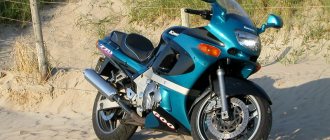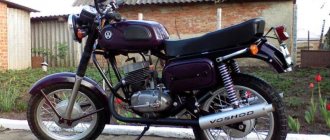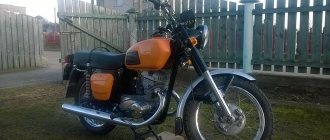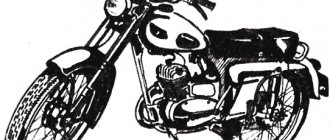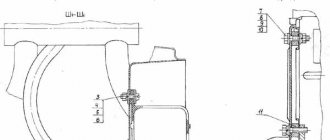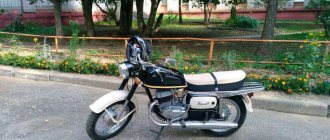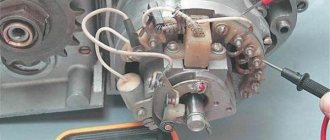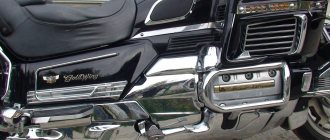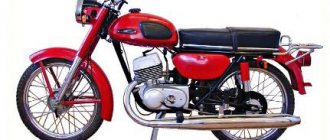Java motorcycles have enjoyed good popularity for a long time, because of the entire Java 350 line, the 638 was the most beloved model. Today, such Java can be found on the streets; it has a huge lifespan. The technical characteristics of the bike are quite good even today.
The motorcycle has been produced since 1985, and even then the model aroused great demand in the market. Java 638 boasted an excellent appearance, a powerful sports engine, a telescopic fork and a high-quality wiring system. Over the entire period of its life, both the engine and the appearance of the motorcycle have been modernized.
Pros:
- low fuel consumption;
- relative ease;
- classic design;
- good dynamics.
Minuses:
- at the present time, 2 bars will not be enough;
- spare parts for Java 638 are sometimes difficult to get even in online stores;
- too dangerous for beginners.
Technical characteristics of Java 538
At that time, Java 350 motorcycles were quite popular, because the work was carried out by a powerful 2-cylinder engine that operated in two-stroke mode. Today this is considered a thing of the past, because it will be much more powerful and cheaper to buy a bike with a four-stroke engine. But despite this, the technical characteristics of the Java 638 give it a good reputation and respect from the current generation.
Java operated on a manual gearbox at 4 speed, which ensured smooth running and gear shifting. Many complain that this is a real bike for craftsmen, because without riding skills you simply will not be able to curb its power. And here it is up to 26 horsepower. The declared volume of the Java engine is 638,343 cc. see. Unfortunately, in those days all motorcycles had only drum brakes; the disc system appeared only in 1994.
Repair and maintenance
The 12-volt generator of the 638 engine was considered one of the best of its time, and the engine generally corresponded to its time, reliable and lightweight. Although there are also disadvantages. The carburetor is very complex for such a simple motorcycle as the Java 350 638. The carburetor does not change the technical characteristics much. It has small jets that become clogged with the smallest particles. The main disadvantage is starting the engine. When the temperature drops deep into the minus, starting the engine turns into torture with shamanic dances and a tambourine. Gasoline has to be poured through the spark plug holes. Over time, starting problems appear in warm weather; cleaning and adjusting the carburetor does not bring much benefit. The instructions include advice to clamp the ventilation holes when starting the engine, but this does not bring any tangible benefit.
Naturally, over time this defect only becomes stronger. Some solve this issue by replacing the carburetor with a carburetor of a different system.
There is a problem with the lack of tires for Java on sale; they use tires from Izhevsk motorcycles for the Java 638 motorcycle. The technical characteristics of the tires are appropriate, except for the nipple for the camera, it is larger. You have to widen the hole in the wheel rim. With the development of motorcycle power, brakes improved more slowly and the Java has a problem with the rear brakes. When you suddenly try to stop, the brake cover turns out the reaction lever, the cable breaks, the wheels are blocked, then the movement is skidding and there is every chance of a coup and fall. This happens due to an oversight by the motorcyclist when the rear wheel axle nut is loosely tightened, but the design itself is flawed. There may simply not be enough threads on the axle.
It is also worth mentioning the steering lock, which can be pulled sharply to the left enough to break the clutch. The drive drum teeth wear out very quickly. Perhaps the reason is the quality of the metal.
Review Java 350 638
This model is considered a continuation of the Java 350 634 motorcycle, the characteristics of which can be viewed at the link. The new model featured a more powerful engine and discreet design. In those years it was considered stylish and sporty, so in the 80s the Java 638 was the dream of thousands of people. The new product also differed from its younger brother in the absence of chrome in some parts. This could be explained by the fact that production was cheaper during release. Unfortunately, the 80s were a difficult period for the USSR, so they were unable to expand production and make the model as popular as the Java Old Woman, produced long before the 638 Java.
Current reviews of the Java 638 characterize the motorcycle as a true friend, which has a pleasant appearance, thoughtful details and, unfortunately, their absence on the market. The biggest disadvantage is the current shortage of parts for this model. There are more than enough motorcycle owners, but even finding Java 638 spare parts in an online store is sometimes difficult. Owners also consider spare parts too expensive.
Motor Java 359 638
Unlike other Java models, this new product had an important feature - the Java 638 cylinders were made of aluminum. Thanks to this innovation, the weight of the structure has been significantly reduced, and thanks to the aluminum fins, air cooling has become even better.
The manufacturer has placed great emphasis on the engine, so its characteristics are competitive even today. Unlike its predecessors, this vehicle has surpassed them in all respects in terms of engine performance. At a maximum speed of 5,500 rpm, it had a torque of 31.38 Nm. But having a 2-stroke system has its advantage - the engine has better distribution of exhaust gases, and the fuel mixture distribution system is now even simpler. Also, repairing a 4-stroke engine will be much more difficult. And most importantly, the maximum speed declared by the manufacturer was 120 km/h, but some owners talk about reaching 130 km/h.
Design Java 638
The most important change in the new product was the presence of a front telescopic fork, which its predecessors did not have. Thanks to this, the Java 638 fork allows you to withstand driving both on a flat track and on a road with difficult surfaces. The general appearance of the motorcycle was quite popular at that time - the absence of plastic, a long and voluminous muffler and the ability to reach any part. The seat on the Java 638 was quite comfortable, you could take one passenger.
The manufacturer also took care to change the location of the fuel tank, which, with a volume of 17 liters, received a special fastening. Thus, when driving fast, almost no vibration is heard from the tank.
It was December 2012, and in the evenings, out of boredom, I was looking through advertisements for the sale of Soviet motorcycles. I wanted something lively and imported for the village. And now a new advertisement has appeared for the sale of JAVA 638-5 “WITH DOCUMENTS, AFTER THE CAPITAL, JUST A GUN. TAKE IT OR YOU WILL REGRET IT!” Photo from the sales site. The price tag was 13 thousand rubles. I remember as if it were yesterday, December 12, on Dubak street -31, school is cancelled, but the purchase of the motorcycle of my dreams cannot be cancelled. I barely found sellers, the private sector is like that. On the way I almost got eaten by dogs, and I thought I’d get frostbite somewhere. The men were engaged in repairing wheelbarrows and painting. This inspired confidence (but in vain). At first glance, the bike was really very elegant, compared to those vehicles that were traveling around the villages. Now I could find a thousand and one comments on the quality of execution. When asked, “Can we warm it up in your box and try to start it?”, they began to deny it. Well, I think, well... with you, the device is worth the money anyway just by its appearance. I paid for the purchase, they gave me (an old technical book) which they called documents (at that time I didn’t even realize that I needed to write some kind of agreement, that a technical passport could be old or new. I only found out when I started digging what was wrong with this stuff continue to do). They dragged it into the garage, so it stood until spring, once a week I went and just looked at it. I liked it so much, it seemed to me that it was the most beautiful motorcycle.
After reading various forums over the winter, I began to have an idea of a motorcycle that was sitting in the garage and waiting in the wings, but that was not the case. When spring came and it was time to awaken Java, she didn’t want to do this, I tried everything I could. As a result, one guy saw everything that was happening and recommended a motorcycle mechanic and gave him a number. We brought him a bike, he disassembled the engine and said a bunch of things and generally said that most likely it was assembled by some hand-assed assholes. But it would not start due to the lack of a labyrinth on the crankshaft. Repairing the engine cost another 15 thousand, it was a Chinese crankshaft, spare parts for the box, re-soldering the wiring since there was no charging, and they did the charging from the Izhevsk BPV, the engine circuit and the repair itself.
And now he is more alive than all the living! They dragged him to the village and exploitation began. Local authorities in the bike community immediately began to say, “I bought a Java and dig a hole.” It’s certainly a funny phrase in the modern world. But I always rode with my head, because health comes first, and I didn’t want to mess up such a beautiful motorcycle. “Their” Izhaks and Urals had nothing to lose. In general, over the years, Java did not give me problems; rather, I created them myself, disassembling and reassembling various components a hundred times in order to “improve” the appearance and eliminate the jambs of previous owners. This is how he lived to this day.
Collective farm punk
Motorcycle Java 638 Lux
There are also two main modifications of the motorcycle - Lux and Super. They have an additional designation in the name - 000. Accordingly, the Lux modification received a special shock absorber, thanks to which it was possible to ride a motorcycle with a trailer. To make driving this version as comfortable as possible, the manufacturer installed rubber inserts for the knees and a new, more comfortable seat.
The exterior has also been improved, resulting in a different control panel and muffler. The cylinders on the Java Lux are now placed vertically, which saves space on the motorcycle.
Motorcycle Java 638 model 5-00
From the second half of 1984, Czechoslovakian Jawa 638-5-00 motorcycles began to arrive in the USSR. This is a transitional model between the well-known Java-634 machine and the new design Java-638-0-00 (“Behind the Wheel,” 1984, No. 10). New engine, electrical equipment, front fork - this is what primarily distinguishes the 638-5-00 model.
Engine. Although its layout has not changed fundamentally, it has undergone a thorough modernization. The cylinders are not made of cast iron, but of an aluminum alloy with a pressed cast iron liner. Aluminum heads now have fins arranged differently. The result is more efficient cooling of the cylinders and heads, and a more uniform distribution of thermal loads. Also, for better cooling, the inclination of the cylinder axes relative to the vertical was reduced from 25 to 15°.
1. The distance between the axes of the cylinders has been increased by 12 mm compared to the YAVA-634 model . This made it possible to install the middle crankshaft journal on two ball bearings in the interests of increasing durability.
Favorable conditions for heat removal made it possible to increase power by increasing the compression ratio, changing valve timing, and improving purging. Thus, an increase of 12 mm in the center-to-center distance of the cylinders made room for four wider bypass channels instead of two and a second ball bearing in the middle crankshaft support. Therefore, the halves of the engine crankcase and its cover have a different shape and size. The two ball bearings of the crankshaft middle support, separated by a labyrinth seal, are now better lubricated by the oil from the combustible mixture entering the crankcase.
2. Now the cylinders are not cast iron: they are cast from an aluminum alloy and have not two, but four purge channels . The piston operates on a cast iron sleeve pressed into the cylinder.
Other changes include a reduction in flywheel diameter from 148 to 144 mm, which improved engine response.
The Jawa 638 motorcycles feature a radically revised engine design with 12-volt electrical equipment.
To take full advantage of all the advantages of the new engine, you must use only the fuel mixture specified in the factory instructions, gasoline having an octane number of 90-93, with oil in a ratio of 33:1 for the break-in period and 40:1 after break-in.
The electrical equipment has been completely updated, since the voltage of the on-board network has increased from 6 to 12 V. The heart of the new electrical equipment is an asynchronous generator, which has become 2.8 times more powerful, although it has remained virtually unchanged in size due to the transition from direct current to alternating current.
The new generator is paired with a six-silicon diode rectifier and a vibration voltage regulator, both located under the saddle next to the battery. Now these devices provide battery charging already at 1000 rpm of the engine, while in the previous model it began only at 1700-1800 rpm. Thus, even when driving at low speeds (in mud, rain, at night), the battery can be reliably charged.
YAVA-638-0-00 is equipped with a new rear light with a larger luminous surface and built-in side reflectors, a new battery (with a transparent case) and a sound signal. Only the lamps in the direction indicators and driver's instruments have changed. As for the headlight, it has a power of 45/40 W and provides so-called asymmetrical light. This innovation helps improve active safety. Another, not so noticeable at first glance, but useful innovation. In order to comply with international standards, the size of the plugs in the electrical wiring has been changed. They now have a nominal size of 6.3 mm and are more reliable.
Transmission. While the gearbox remained almost the same as that of the 634 model, the clutch was reconstructed. This is due to the fact that the power and torque transmitted to them have now increased and, in order to increase durability, especially in difficult road conditions, the outer and inner diameters of the friction discs, and therefore their friction surface, have been increased. The overall spring force has been reduced by 15%.
According to the characteristics of the engine, the rear gear ratio has been changed: its drive sprocket now has not 18, but 17 teeth.
The chassis has also undergone a number of changes. First of all, the front fork, borrowed from the ChZ-472 motorcycle. The diameter of the supporting pipes has been increased to 36 mm, and the sealing of the rods has been improved. The new fork provides more effective vibration damping, increased rigidity, and lower unsprung masses. Its stroke is now 175 mm.
3.New front fork and brake are borrowed from the CZ-472 motorcycle.
For operation with a side trailer, the machine is equipped with a rear gear sprocket, which provides a larger gear ratio, as well as a shock absorber that dampens the angular vibrations of the front fork, which is equipped with springs with increased preload. In addition, this modification (its index is “638-5-01”) has a non-reclining left footrest and no protective bars.
Decor. A new front fork, a different shape of engine parts, as well as a redesigned taillight and gas tank design along with the seat panels significantly changed the appearance of the motorcycle. Among the important, but invisible at first glance, details are the elastic fastening of the fuel tank, the elongated front part of the muffler, which contributed to an increase in power.
V. GROSMAN
From the editor. The magazine will talk about further modernization of Jawa motorcycles, improving their performance indicators, improving quality and reliability in accordance with the wishes of Soviet consumers in one of the upcoming issues, where material will be published about our correspondent’s visit to the Jawa and CZ factories.
Appearance
The main changes affected the rear light. However, the design of the working parts has also changed. The front telescopic fork stands out more from the general background. The engine components have become more visible and closer to the exhaust system. The muffler itself has become a little longer and bulkier. Its increase increased the power of the unit. Moreover, the tank on the 85 model is fixed in a unique way, so vibrations are almost not transmitted to it.
In conclusion, I would like to say that the YAVA 638, whose fuel consumption is about 6-7 liters per 100 kilometers, is an ideal option for the rural population . The ability to transport passengers, off-road capability and transport cargo on an installed trailer makes it indispensable in the agricultural industry.


